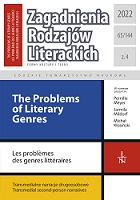Exploring the Boundaries of Second-Person Narrative: The Use of “You” in Maria Gerhardt’s Transfer Window
Exploring the Boundaries of Second-Person Narrative: The Use of “You” in Maria Gerhardt’s Transfer Window
Author(s): Pernille MeyerSubject(s): Studies of Literature, Other Language Literature, Theory of Literature, Sociology of Literature
Published by: Łódzkie Towarzystwo Naukowe
Keywords: second-person narrative; fictionality; narratology; autobiography; Maria Gerhardt;
Summary/Abstract: In Maria Gerhardt’s autobiographical novel, Transfer Window (orig. Transfervindue, 2017), which is set in a fictionalized hospice universe and revolves around Gerhardt’s experience of being a terminal patient, the first-person protagonist, Maria, consistently refers to her partner as “you” without addressing her. This odd pronominal use is typically associated with second-person narrative. Yet, according to most definitions, Transfer Window is not a second-person narrative because of its 1) autobiographical content and 2) first-person protagonist. In this article, I argue that second-person narrative is any narrative in which a “you” is designated, but not addressed, and present a new typology consisting of four different types of second-person narrative: 1) fictional second-person narrative without a marked instance of enunciation, 2) fictional second-person narrative with a marked instance of enunciation, 3) nonfictional second-person narrative without a marked instance of enunciation and 4) nonfictional second-person narrative with a marked instance of enunciation. My approach to second-person narrative is rooted in rhetorical fictionality theory, which provides a framework that allows me to view second-person narration as a narrative technique that, because of its odd pronominal use, signals fictionality, but can occur in both generic fiction and nonfiction. In my analysis of Transfer Window, I dive into Gerhardt’s use of fictionality, both in relation to the setting and the narrative situation of the book.
Journal: Zagadnienia Rodzajów Literackich
- Issue Year: 65/2022
- Issue No: 4
- Page Range: 19-33
- Page Count: 15
- Language: English

